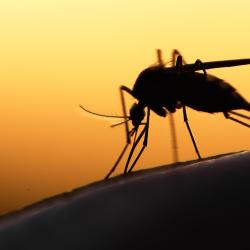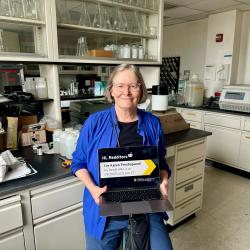Models May Underestimate the Impact of Climate Change
The discussion and debate around climate change is taking a new turn. CMNS researchers are raising key questions about the validity of certain data sets. Their work indicates that, in some cases, climate models and experiments may underestimate the effects of climate changes on the environment.
Warming temperatures may play more havoc on plant life cycle events than previously predicted, says Nathan Kraft, an assistant professor of biology. For at least 20 years, researchers have known that global warming impacts phenology—the seasonal timing of recurring events in plant and animal life—prompting plants to flower and leaf earlier than they have historically, explains Kraft.
To better understand this effect, scientists conduct experiments in which they artificially warm a community of plants with overhead infrared lamps, ground heaters or open-top chambers. Even though researchers have used the data for decades to extrapolate plant responses to climate change, they have never extensively tested whether the experiments sufficiently mimic nature until now, according to Kraft.
An international working group of scientists, including Kraft, recently compared the data from short-term warming experiments with long-term observational data about the phenology of plant communities in nature. The researchers were alarmed to find a mismatch. “What was surprising is that the experiments tended to underpredict the severity of the changes that have been charted in nature through long-term observations,” says Kraft. The team published its findings in Nature in 2012.
The warming experiments lowball the advances in the timing of flowering and leafing by more than eightfold and fourfold, respectively. For example, observational data indicated that warming a plant community by 1 degree Celsius caused plants to flower four to five days earlier, while the experimental data predicted flowering occurred roughly one day early. Even when only comparing species found in both the experiments and the natural plant communities, the experiments predicted that warming would have less impact than was actually observed in nature.
“This is a wakeup call,” says Kraft. “Researchers need to think more carefully about how they design these experiments,” he says, pointing out that changes in additional factors like precipitation and increased pollution over the course of the long-term observations may contribute to the discrepancies.
Ecologists are concerned that shifting phenology could affect the entire ecosystem. “If a pollinator, such as a hummingbird or butterfly, is also sensitive to changes in temperature, but not to the same degree as a host plant, a plant could flower at a time when its pollinator is not present,” says Kraft. This mismatch in timing could negatively impact pollinator populations as well as reduce the reproductive success of the associated plants.
How One Ecosystem Change Leads to Another
Not only does global warming impact vegetation, but the opposite may be true. Changes in vegetation can escalate climate change in some regions of the world, says Ning Zeng, an associate professor in atmospheric and oceanic science. His research shows that climate change may affect subtropical regions more severely than previously projected due to complex interactions of the atmosphere-land-vegetation-ocean system.
Warmer temperatures in the subtropics lead to increased evaporation, explains Zeng. As the soil becomes arid, vegetation naturally decreases. “This change in the ecosystem can come back to modify the climate, making it even drier,” says Zeng, whose research explores this feedback mechanism.
With less vegetation, the surface reflects more sunlight. Scientists refer to this phenomenon as “increased albedo,” and Zeng’s model shows it could have dire effects. “Increased albedo reduces the monsoon strength and further weakens the moisture supply that comes from the ocean,” he explains. The result: drier conditions with even less vegetation. The cycle continues, and the desert widens. The research leads Zeng to anticipate a far greater increase in desert areas than predicted by the Intergovernmental Panel on Climate Change (IPCC) in its 2007 Fourth Assessment Report.
A typical IPCC model simulation shows an increase in the world’s “warm desert” area of 2.5 million km2, or 10 percent, from 1900 to the end of the 21st century. “In a more realistic simulation where the vegetation-albedo feedback is allowed to interact, the warm desert area expands by 8.5 million km2, or 34 percent,” says Zeng. He projects an expansion of the world’s major subtropical deserts such as the Sahara, the Kalahari, the Gobi and the Great Sandy Desert, and has recommended that the vegetation-albedo feedback be included in future IPCC climate projections.







